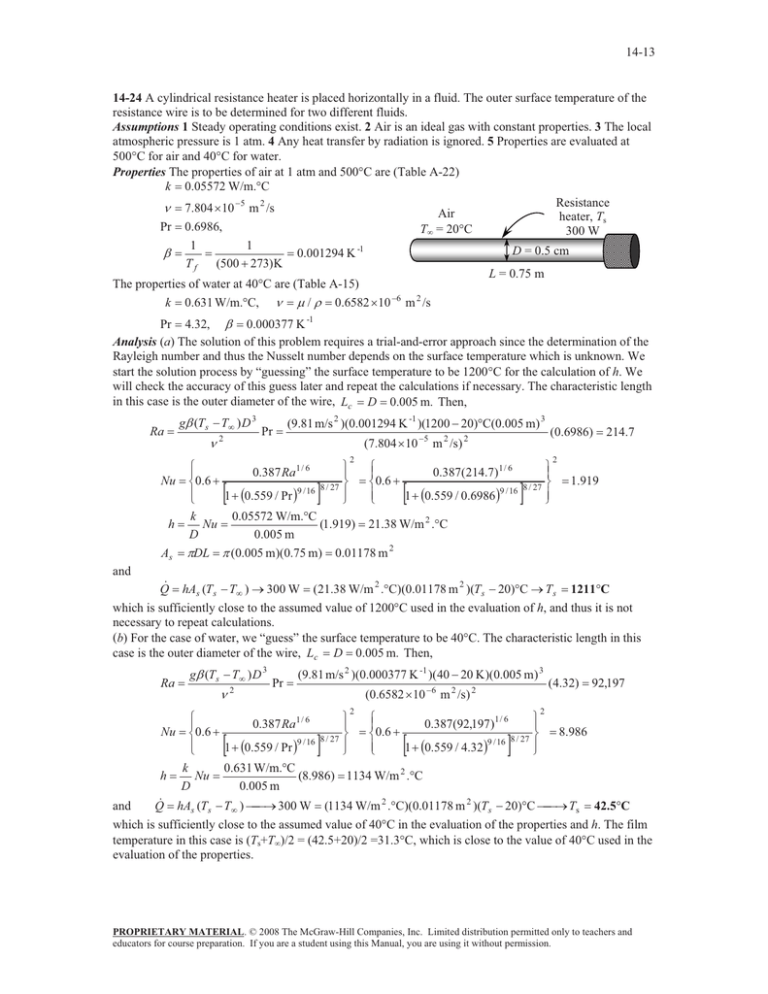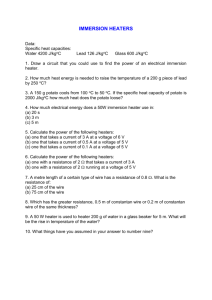14-13 resistance wire is to be determined for two different fluids.
advertisement

14-13 14-24 A cylindrical resistance heater is placed horizontally in a fluid. The outer surface temperature of the resistance wire is to be determined for two different fluids. Assumptions 1 Steady operating conditions exist. 2 Air is an ideal gas with constant properties. 3 The local atmospheric pressure is 1 atm. 4 Any heat transfer by radiation is ignored. 5 Properties are evaluated at 500qC for air and 40qC for water. Properties The properties of air at 1 atm and 500qC are (Table A-22) k 0.05572 W/m.qC Resistance Q 7.804 u 10 5 m 2 /s Air heater, Ts Pr 0.6986, Tf = 20qC 300 W 1 1 D = 0.5 cm E 0.001294 K -1 (500 273)K Tf L = 0.75 m The properties of water at 40qC are (Table A-15) k 0.631 W/m.qC, Q P / U 0.6582 u 10 6 m 2 /s Pr 4.32, E 0.000377 K -1 Analysis (a) The solution of this problem requires a trial-and-error approach since the determination of the Rayleigh number and thus the Nusselt number depends on the surface temperature which is unknown. We start the solution process by “guessing” the surface temperature to be 1200qC for the calculation of h. We will check the accuracy of this guess later and repeat the calculations if necessary. The characteristic length in this case is the outer diameter of the wire, Lc D 0.005 m. Then, gE (Ts Tf ) D 3 Ra Q2 Nu h As and Q Pr (9.81 m/s 2 )(0.001294 K -1 )(1200 20)qC(0.005 m) 3 (7.804 u 10 5 m 2 /s) 2 ­ 0.387 Ra 1 / 6 ° 0 . 6 ® °̄ 1 0.559 / Pr 9 / 16 k Nu D > ½ ° 8 / 27 ¾ °¿ 2 @ 0.05572 W/m.qC (1.919) 0.005 m ­ 0.387(214.7)1 / 6 ° 0 . 6 ® °̄ 1 0.559 / 0.69869 / 16 > (0.6986) ½ ° 8 / 27 ¾ °¿ 214.7 2 @ 1.919 21.38 W/m 2 .qC SDL S (0.005 m)(0.75 m) 0.01178 m 2 1211qC which is sufficiently close to the assumed value of 1200qC used in the evaluation of h, and thus it is not necessary to repeat calculations. (b) For the case of water, we “guess” the surface temperature to be 40qC. The characteristic length in this case is the outer diameter of the wire, Lc D 0.005 m. Then, Ra Nu h hAs (Ts Tf ) o 300 W gE (Ts Tf ) D 3 Q2 Pr (21.38 W/m 2 .qC)(0.01178 m 2 )(Ts 20)qC o Ts (9.81 m/s 2 )(0.000377 K -1 )(40 20 K )(0.005 m) 3 ­ 0.387 Ra 1 / 6 ° ®0.6 °̄ 1 0.559 / Pr 9 / 16 k Nu D > (0.6582 u 10 6 m 2 /s) 2 ½ ° 8 / 27 ¾ °¿ @ 2 ­ ½ 0.387(92,197)1 / 6 ° ° 0 . 6 ® ¾ 9 / 16 8 / 27 °̄ °¿ 1 0.559 / 4.32 > 0.631 W/m.qC (8.986) 1134 W/m 2 .qC 0.005 m @ (4.32) 92,197 2 8.986 and Q hAs (Ts Tf ) o 300 W (1134 W/m 2 .qC)(0.01178 m 2 )(Ts 20)qC o Ts 42.5qC which is sufficiently close to the assumed value of 40qC in the evaluation of the properties and h. The film temperature in this case is (Ts+Tf)/2 = (42.5+20)/2 =31.3qC, which is close to the value of 40qC used in the evaluation of the properties. PROPRIETARY MATERIAL. © 2008 The McGraw-Hill Companies, Inc. Limited distribution permitted only to teachers and educators for course preparation. If you are a student using this Manual, you are using it without permission.




